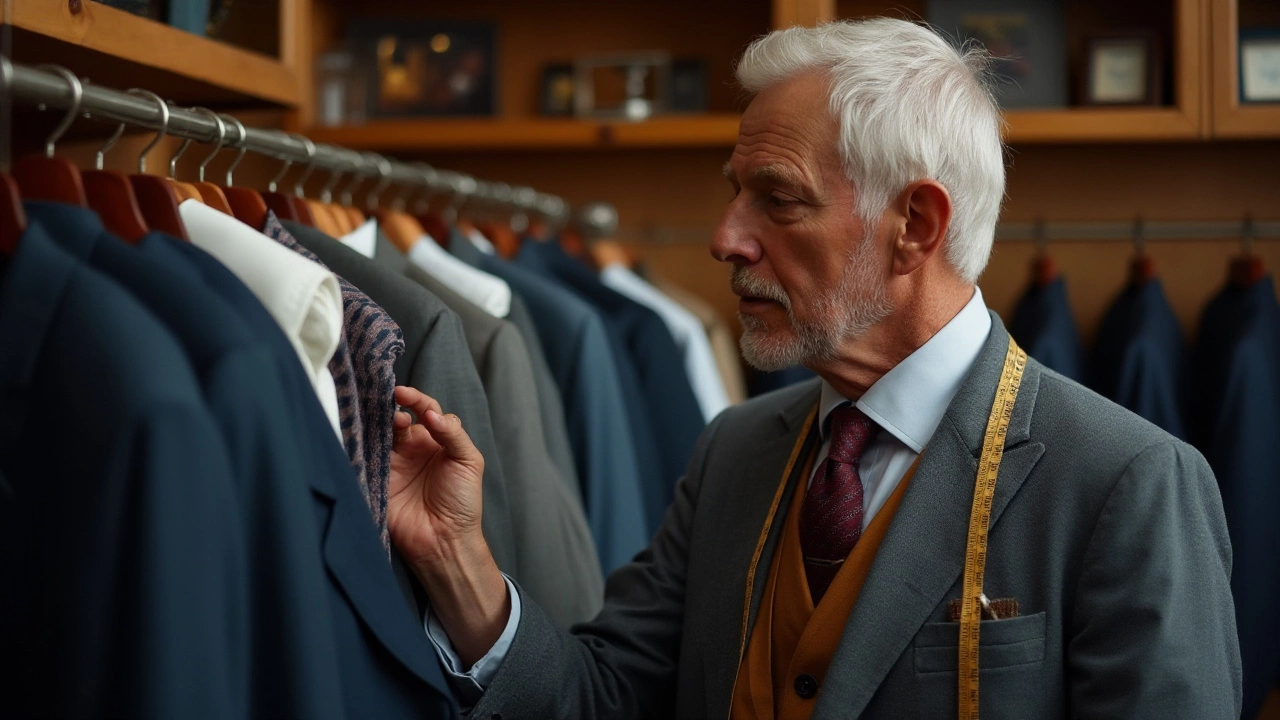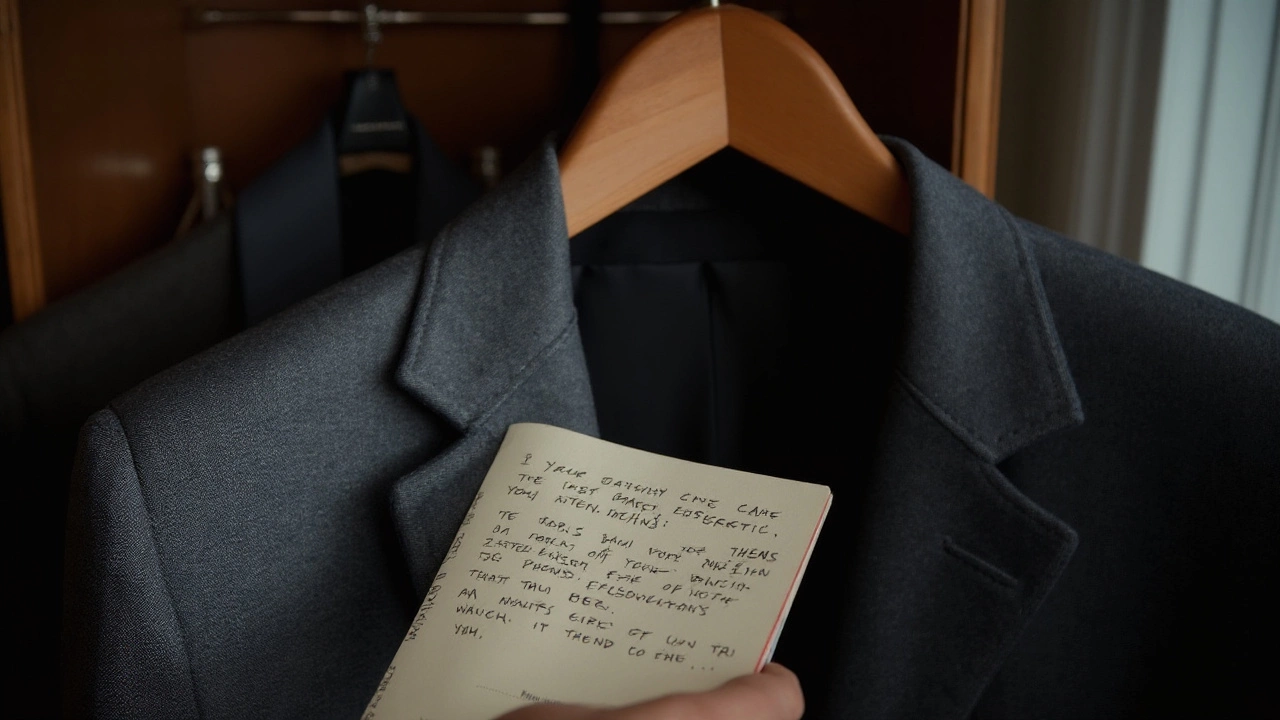Evaluating a $300 Suit: Worth the Price or Not?

- Cleo Fairchild
- 22 December 2024
- 0 Comments
When contemplating the purchase of a suit, many individuals wonder if $300 is enough to get them fashionably suited without a hitch. In a market filled with varied options, this price point is intriguing as it sits comfortably between budget and mid-range offerings. It begs the question—do you walk away with something that promises not just style, but longevity, too?
For an investment like this, understanding what you're really paying for will make all the difference. From fabrics and stitching to the overall fit, each component plays a significant role in determining if that $300 suit will stand the test of time. Building a solid foundation of knowledge around these elements could transform your shopping experience from a guessing game into an informed decision-making process.
Let's explore what exactly goes into a suit at this cost, how it might serve your wardrobe, and discover some savvy shopping tips that can maximize your wardrobe investment. With an eye for detail and a little patience, finding the right suit within this budget is not just a possibility; it's an opportunity waiting to be tailored just for you.
- Understanding Suit Pricing
- The Materials and Construction
- Fit and Personalization
- Tips for Buying a $300 Suit
Understanding Suit Pricing
In the world of men's fashion, the pricing of a suit can often mirror the intricacy of the fabric it is crafted from. When delving into the intricacies of a $300 suit, it's essential to recognize what components are typically prioritized at this price point. Generally, a suit at this cost strikes a balance between quality and accessibility. It offers a gateway into the realm of refined clothing without the financial commitment demanded by luxury brands. With men's suits, understanding how various factors like brand reputation, material choices, and manufacturing processes impact the price can offer valuable insights.
Firstly, one must consider the material. At a $300 price point, you may encounter a mix of fabrics. While pure wool suits are often considered the gold standard due to their breathability and durability, a suit of this price might be made of a wool blend or even a high-quality synthetic. These alternatives aim to provide a similar look and feel, sometimes with added benefits like wrinkle resistance. Recognized brands often invest in ensuring that these materials, though economical, still elevate one's stature once worn. It's interesting to note how some brands employ advanced textile technology to mimic higher-grade fabrics and still maintain affordability.
The construction and tailoring process is another critical component that influences the cost. A well-made $300 suit will likely be partially machine-stitched with some hand-finished details to achieve a hold of traditional craftsmanship. While it may lack the precision of hand-stiched luxury suits, modern technology permits a level of precision that was once unimaginable. These techniques help keep the price reasonable without sacrificing too much on style or durability. Affordable suits made this way provide a great opportunity for those who want to look sharp without overextending their budget.
When discussing the cost of a suit, one cannot overlook the impact of branding. Well-established fashion houses have the advantage of a history of quality and an inherent trust that less-known companies might struggle to compete with. This brand value contributes to the pricing model. Yet, there are emerging brands that focus on offering competitive pricing with a strong promise of quality and style, capitalizing primarily on the delights of word-of-mouth marketing. In fact, as fashion expert James Smith mentions,
"Sometimes a lesser-known brand offers the unexpected edge in quality and detail, making it a hidden gem in the cluttered sea of retail."Choosing a suit becomes a reflective decision, considering not just the label but where the actual value lies.
While the allure of lavish suits can be intoxicating, understanding the breakdown of a $300 suit can enrich the buying experience. It empowers consumers to ask the right questions and make informed decisions. These suits, offering a beautiful blend of practicality and style, capture everything necessary to complement one's wardrobe beautifully, proving that fashion doesn't always equate to excessive splurging. And with knowledge, the journey from shop to closet becomes not just an exercise in style but also an exploration of modern textile craft.

The Materials and Construction
When it comes to buying a suit, especially with a budget around $300, understanding the materials and construction involved can make all the difference in your selection. Often, suits in this price range are made from a blend of fabrics. For instance, while 100% wool is the hallmark of classic suit elegance, a blend of wool and synthetic fibers like polyester is quite common in more affordable options. This mix not only helps in keeping costs low but also introduces advantages like wrinkle resistance and durability, a plus for those who may not indulge in frequent dry cleaning.
The construction aspect is equally pivotal. Suits are typically categorized based on whether they are fused or canvassed. A fused suit, which comprises the majority at this price level, involves an additional layer ironed between the fabric and the lining. While it tends to create a somewhat stiffer fit, technological advancements mean that a well-crafted fused suit can mimic the look of a pricier canvassed suit to the untrained eye. Investing the time to feel the fabric and assess the weight or seeing how naturally the suit hangs on you in front of a mirror under natural light are both advisable strategies.
Reputable brands or experienced tailors might even offer semi-canvassed suits for $300, though these are rarer gems. Such a suit provides a half-layer that extends through the chest and lapel only. This construction leads to a roll in the lapel with a pleasant curve absent in fully fused suits, enhancing the garment's aesthetic and comfort over time as it molds subtly to one's physique. "A suit is an investment in both style and substance," says David Corp, a tailor known for his craftsmanship and eye for detail.
The devil, as they say, is in the details. The fabric tells a story; you must listen carefully.
Besides, considering the lining material can elevate one's experience of wearing a suit. Bemberg or viscose linings are breathable, making them superior to polyester linings, which tend to trap heat. Such considerations, though small, make a significant impact on comfort and may even affect one's demeanor and confidence while wearing the suit. A table outlining some common suit materials and their characteristics provides a quick reference when shopping:
| Material | Pros | Cons |
|---|---|---|
| Wool Blend | Durable, Resilient | Can be Less Breathable |
| Polyester | Cost-Effective, Wrinkle-Resistant | Can Look Less Luxurious |
| Viscose Lining | Breathable, Soft | May be Less Durable |
Armed with this information on materials and construction, selecting your next suit becomes less of a gamble and more of an informed choice. By valuing the components that contribute to a suit's construction, a buyer can better gauge the long-term value of their purchase, ensuring the investment not only fits the budget but also meets the sartorial ambitions.

Fit and Personalization
One of the most significant factors when considering a $300 suit is how it fits and the potential for personalization. A suit that doesn't fit well can ruin the entire look, regardless of how much it cost. Achieving the perfect fit often requires an understanding of body measurements, the cut of the suit, and perhaps, minor adjustments. Many stores selling suits in this price category offer basic tailoring services, which can be invaluable in making that off-the-rack suit seem as though it was made just for you.
A suit's major components such as the jacket and trousers should complement your frame. Ideally, the jacket should lay flat across the back without pulling and should not be too tight around the shoulder blades. The sleeve lengths should stop just at the wrist bone, ensuring a peek of the shirt's cuff. Remember, when buying men's suits, small details significantly affect the final appearance. Adding to this, pants should comfortably rest on the top of the shoes, offering a slight break in the fabric.
Customization often goes beyond just altering lengths and narrowing waists. Some stores offer options to personalize lapels, buttons, and even linings for suits in this affordable suits range. A contrasting lining or unique buttons can create a bespoke feel without a hefty price tag. These custom touches can bring about confidence, a sentiment echoed by fashion expert Tom Ford who stated,
"Dressing well is a form of good manners."This quote underscores the sentiment that a well-tailored, personalized suit communicates care and sophistication.
However, keep in mind fashion trends while selecting cuts and styles. A timeless choice would be a notch lapel and dual vents on the jacket, which offers classic aesthetics and versatility. Suits at this price point often let you choose between slim-fit and regular-fit cuts. While slim-fit suits offer a modern edge, they might not suit every body type, and this is where personal preference and comfort play a fundamental role. If you chance upon a sales assistant with expertise, they can often guide you towards what's both fashionable and flattering.
Lastly, there's the consideration of personalization in terms of fabric care to ensure longevity. A well-cared suit, even in the modest price bracket of $300, can offer years of service. This involves rotating wear, spot cleaning, and occasional professional dry cleaning to maintain the fabric's integrity. As the men’s wardrobe staple, a suit denotes sophistication, and caring for it reflects back on your image.

Tips for Buying a 0 Suit
Embarking on the journey to purchase a men's suit within a $300 budget is thrilling. It requires a discerning eye and a strategic approach to shopping. First, pay close attention to the suit's fabric—wool is king in this domain, offering a balance of comfort and durability, yet you'll also find blended materials like polyester in this range. These blends can offer the appearance of wool at a lower cost, though they may not hold the same longevity. Consider this a trade-off if you are keen on keeping your new attire in shape for years to come.
Fit is another crucial component. Off-the-rack suits often require alterations for that bespoke look. Finding an experienced tailor willing to make adjustments to enhance your suit's fit should be on your checklist. A well-fitted suit can elevate your appearance significantly. Focus on how the shoulders sit, as they are the most challenging part to alter. Sleeves and trousers can be more easily adjusted to suit your exact measurements, thus ensuring a snug fit without the hefty price tag of custom tailoring.
Brands, too, play a significant role in your decision-making process. Some brands within this price range, like J.Crew Factory or H&M, promise a dash of modern style without breaking the bank. While these brands may not carry the pedigree of Italian fashion houses, they do offer trendy styles that make a statement. Investing time in researching reviews and perhaps visiting stores to try on different styles can work wonders. Don't shy away from online options, either, but be sure to check return policies to facilitate stress-free returns.
When you're out shopping, seasonal sales can offer incredible opportunities. Black Friday, Cyber Monday, and mid-year sales often see prices slashed significantly. This is an excellent chance to snag a more premium label for your designated budget. Remember, patience can be your best ally in scoring a bargain. Lastly, educate yourself on proper suit care—it extends the suit's life far beyond the initial wear. Regular dry cleaning, proper storage, and using a quality garment steamer can do wonders in maintaining the suit's crisp look.
Online and In-Store Shopping
Shopping for suits has evolved into a blend of in-store experiences and convenient online options. If opting for online purchases, ensure you know your measurements well. Many retailers provide detailed sizing charts that accommodate every fit, from slim to classic. While online shopping offers plenty of choices, nothing beats the tactile experience of feeling the fabric and seeing the true colors up close, as store lighting often differs from home settings. It's worth visiting some stores to try various styles, which can also help when later comparing online options.
"The simplest way to be understood is to make yourself clear. In the suit world, clarity comes from wearing something that fits right and feels comfortable." — A respected stylist
With these guidelines, navigating the realm of $300 suits becomes less daunting and more of an adventure. By focusing on critical elements like material, fit, and brand reliability, and maintaining an eye for deals, finding a suit that offers style and lasting value becomes not just a possibility but an attainable reality.


